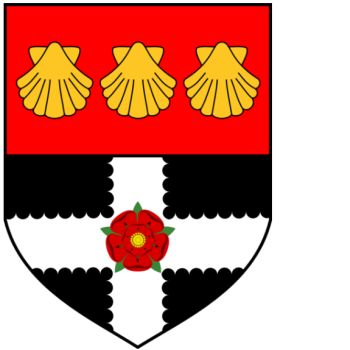University of Reading: Difference between revisions
Knorrepoes (talk | contribs) No edit summary |
Knorrepoes (talk | contribs) |
||
| (14 intermediate revisions by the same user not shown) | |||
| Line 1: | Line 1: | ||
{ | {{uk}} | ||
| Line 11: | Line 7: | ||
Campus/location : [[Reading (Berkshire)|Reading]] | Campus/location : [[Reading (Berkshire)|Reading]] | ||
[[File:uni-reading.jpg|center]] | [[File:uni-reading.jpg|center|Arms of {{PAGENAME}}]] | ||
===Official blazon=== | |||
Per fesse gules and sable, in chief three escallops fessewise Or, and in base on a cross engrailed argent a rose of the first barbed and seeded proper. | Per fesse gules and sable, in chief three escallops fessewise Or, and in base on a cross engrailed argent a rose of the first barbed and seeded proper. | ||
===Origin/meaning=== | |||
The arms were officially granted on August 7, 1896 (to the Reading University Extension College and | The arms were officially granted on August 7, 1896 (to the Reading University Extension College and continuedby the whole university). | ||
The arms of the University of Reading were granted when the newly incorporated University Extension College at Reading was still part of Oxford University. This was thirty years before it was granted a Royal charter and became a university in its own right. | |||
[[Literature]]: | On the lower portion of the shield is the Lancaster Rose that forms part of the arms of the Royal County of Berkshire. This is set on an engrailed cross derived from the arms of [[Christ Church College (Oxford University)|Christ Church Oxford]], to whose initiative the Extension College owed its foundation. The arms of Christ Church were those of Cardinal Wolsey who in 1525 founded Cardinal College, later renamed as Christ Church by Henry VIII in 1546. | ||
The three scallop shells on the upper part of the shield had been the arms of Reading Abbey founded in 1121 and their presence serves as a reminder that the first college was once part of the Abbey. | |||
It is also possible that the scallop shells, a symbol of a pilgrim or 'palmer' might allude to the arms of the local family, the Palmers. Walter Palmer, son of the co-founder of the Huntley and Palmers biscuit firm that came to Reading in the 1840s, was the first President of Reading University Extension College and the family has been and remain benefactors of the University today | |||
{{media}} | |||
[[Literature]]: Ailes, 1995 | |||
[[Category:United Kingdom (Universities)]] | [[Category:United Kingdom (Universities)]] | ||
[[Category:Universities]] | [[Category:Universities]] | ||
[[Category:Granted 1896]] | [[Category:Granted 1896]] | ||
Latest revision as of 07:32, 15 December 2021
| Heraldry of the World |
| British heraldry portal Civic heraldry of the United Kingdom |
|
UNIVERSITY OF READING
Country: United Kingdom
Campus/location : Reading
Official blazon
Per fesse gules and sable, in chief three escallops fessewise Or, and in base on a cross engrailed argent a rose of the first barbed and seeded proper.
Origin/meaning
The arms were officially granted on August 7, 1896 (to the Reading University Extension College and continuedby the whole university).
The arms of the University of Reading were granted when the newly incorporated University Extension College at Reading was still part of Oxford University. This was thirty years before it was granted a Royal charter and became a university in its own right.
On the lower portion of the shield is the Lancaster Rose that forms part of the arms of the Royal County of Berkshire. This is set on an engrailed cross derived from the arms of Christ Church Oxford, to whose initiative the Extension College owed its foundation. The arms of Christ Church were those of Cardinal Wolsey who in 1525 founded Cardinal College, later renamed as Christ Church by Henry VIII in 1546.
The three scallop shells on the upper part of the shield had been the arms of Reading Abbey founded in 1121 and their presence serves as a reminder that the first college was once part of the Abbey.
It is also possible that the scallop shells, a symbol of a pilgrim or 'palmer' might allude to the arms of the local family, the Palmers. Walter Palmer, son of the co-founder of the Huntley and Palmers biscuit firm that came to Reading in the 1840s, was the first President of Reading University Extension College and the family has been and remain benefactors of the University today
Contact and Support
Partners:
Your logo here ?
Contact us
© since 1995, Heraldry of the World, Ralf Hartemink 
Index of the site
Literature: Ailes, 1995












